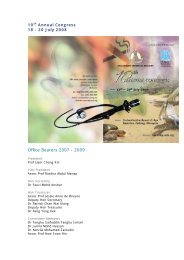download - Malaysian Thoracic Society
download - Malaysian Thoracic Society
download - Malaysian Thoracic Society
You also want an ePaper? Increase the reach of your titles
YUMPU automatically turns print PDFs into web optimized ePapers that Google loves.
Annual Congress of <strong>Malaysian</strong> <strong>Thoracic</strong> <strong>Society</strong><br />
PP 29<br />
Prevalence Of Snoring And Obstructive Sleep Apnoea In Overweight<br />
Children In A Tertiary Hospital<br />
Izzurina Bashah, Anna Marie Nathan, Jessie A de Bruyne<br />
University of Malaya, Kuala Lumpur, Malaysia<br />
Introduction<br />
Obstructive sleep apnoea (OSA) produces significant morbidity especially in the overweight but confirmatory<br />
polysomnogram (PSG) is not readily available.<br />
Objectives<br />
To determine the prevalence of snoring and OSA in overweight children in a tertiary hospital and to identify<br />
risk factors associated with OSA in these children.<br />
Methodology<br />
In this cross-sectional study from 1st October 2009 till 31st January 2011, 89 overweight children seen in UMMC<br />
paediatric clinics and wards were enrolled by convenience sampling. A set of questionnaires pertaining<br />
to demographic data, a Paediatric Sleep Questionnaire (PSQ) and Epworth Sleepiness Scale (EPSS) were<br />
administered, followed by a simple examination. Patients who had positive sleep scores or had at least one<br />
significant symptom of OSA (secondary nocturnal enuresis, increased work of breathing or witnessed apnoea<br />
during sleep) underwent a PSG. Results were analysed using SPSS17.<br />
Results<br />
Ninety-one percent (n = 81) of children were obese. Sixty-four children (71.9%) snored with 28(31.5%) being<br />
habitual snorers. A PSG was indicated in 32 children (24 completed). Fourteen children had OSA on PSG.<br />
Factors that were significantly associated with OSA were mouth breathing (both on parental report and<br />
physical examination), secondary nocturnal enuresis, difficulty in breathing at night and observed apnoea<br />
during sleep, high EPSS score, and tonsillar size. In multivariate logistic regression, the EPSS score (p =<br />
0.013) and difficulty in breathing at night (p








